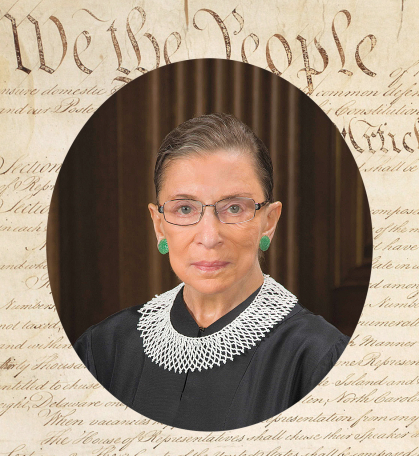The Rights of Women
IN REMEMBRANCE: Ruth Bader Ginsburg | 1933–2020

Years before Ruth Bader Ginsburg began an unprecedented career on the United States Supreme Court, the second woman ever appointed to the court, she had become an intrepid pioneer for women and gender equality. Ginsburg, who died on September 18 from pancreatic cancer at age 87, was a professor at Rutgers Law School in Newark from 1963 to 1972, a formative period that jump-started her desire to advocate for women’s rights. By the time she left Rutgers as a tenured professor, she was determined, as a lawyer, to challenge women’s second-class status.
She herself had been a victim of discrimination. One of only nine women in her Harvard Law School class of 552 and an editor of its law review, Ginsburg was nonetheless passed up for clerkships. She transferred to Columbia and after graduating in 1959 as the top student, she couldn’t find a job at a New York law firm. She briefly worked at Columbia on a comparative law project on civil procedure, requiring her to learn Swedish and to spend time in Sweden, where feminism thrived and where women, aided by ample child care support, combined work and family obligations. Joining the Rutgers Law School faculty, as one of only two women, she spent seven years assembling the definitive treatise on Swedish civil law. Her Swedish experience revealed to Ginsburg how society could, and should, be organized differently.
Her Rutgers students played a role in the ongoing evolution of her legal thinking. In 1969, several students asked if the law school could offer a seminar on women and the law. Ginsburg, discovering there was very little information on the subject, developed and led the seminar. She volunteered as a faculty adviser in helping to found the Women’s Rights Law Reporter, the first law journal in the United States to address women’s rights exclusively. She also handled discrimination cases for the New Jersey affiliate of the American Civil Liberties Union and, in 1972, was selected as founding director of its Women’s Rights Project.
“Rutgers students sparked my interest and aided in charting the course I then pursued,” Ginsburg said in an appearance in Our Revolutionary Spirit, a short film about Rutgers’ 250th anniversary. “Less than three years after starting the seminar, I was arguing gender discrimination cases before the Supreme Court.”
From 1973 to 1978, Ginsburg argued six cases before the Supreme Court, winning five of them and establishing legal landmarks. In each, she effectively persuaded the court to appreciate that the 14th Amendment’s guarantee of equal protection applied not only to racial discrimination, but also to discrimination based on sex. After serving on the United States Court of Appeals from 1980, she was seated on the Supreme Court in 1993, nominated by President Bill Clinton. By the time of her death, Ginsburg was a cultural phenomenon for generations of women and a popular icon for young women now living in a world that Ginsburg did so much to change for them.